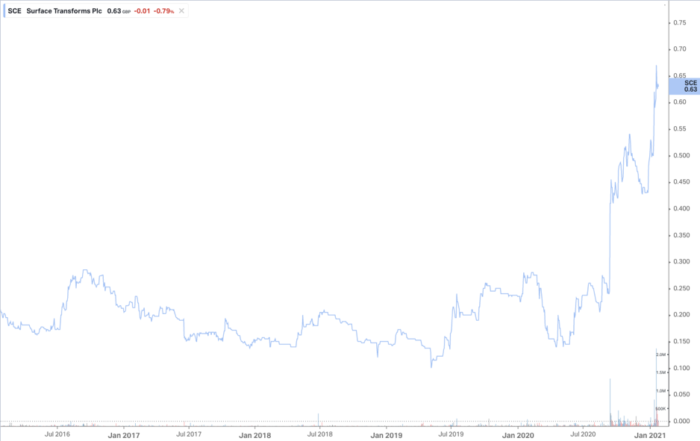Stock Alert: the overnight success 28 years in the making
27th January 2021 |
I wanted to release your latest recommendation to you slightly out of schedule, because I wanted to get this recommendation to you now that I believe the entry point for this stock is at an appropriate level.
This recommendation was actually the one I had intended to get out to you on 14 January.
But as mentioned, unusual trading in the stock gave me sufficient reason to pause before releasing it.
The stock continued to trade higher off the back of a couple of announcements that came up after we had prepared the recommendation and in the weeks since.
Notably came the announcement the company was doing a bookbuild, raising funds to “… build upon its current contract expected revenue pipeline”. That announcement also informed the market of another opportunity for the company to grow its pipeline of deals and potential market opportunities.
I now believe it was this information that somehow made it into the market right before we recommended it to you that caused the unusual trading, giving us reason to pause the recommendation.
However, the stock has cooled since these announcements and is now at an entry point where I’m happy bringing it to you considering the market potential the company has.
You can find the recommendation and analysis below.
The overnight success 28 years in the making
One of the most iconic and emotive feats of engineering of the 20th century was the development and debut of the Concorde.
On 21 January 1976 British Airways flew the Concorde in the world’s first scheduled supersonic passenger service. It was an engineering marvel. It pioneered a huge number of cutting-edge technologies from fly-by-wire control systems, to the hybrid circuit, computerised engine controls and an immense use of electronics.
Design wise it was like nothing else in the skies. Obviously because it would fly at supersonic speeds. Breaking the speed of sound marginally wasn’t the idea here, the idea was to smash it. And at maximum cruising speed the Concorde would push through to Mach 2.04, hitting around 1,484 mph.
It was also exclusive. It had only 25 rows of seats, two on each side. Hence with a bit of simple maths, one flight could only take a maximum of 100 passengers.
Therefore, the Concorde had only one level of service, one kind of “class”… first class.
That’s because tickets had to be unobtainably expensive because the things was so damn expensive to run. Flying at Mach 2 meant it would consume 22,000 litres of jet fuel per hour.
Still, it had well over 26 years of service. On 7 February 1996 it flew the fastest ever New York to London flight – two hours and 53 minutes between take-off and touchdown… Geez, imagine having access to that speed today…
It was nothing short of a breakthrough, awe-inspiring engineering and technological masterpiece. Even today, no other aircraft has come close to the glamour, the aspiration, the technology, the speed and the exclusivity of the Concorde.
However, as you’re well aware, the Concorde for all its glory found itself in the wrong place, at the wrong time, enough times, to send it out of service.
It was insanely expensive to build. It was insanely expensive to run. With grand plans to have around 500 of them in the skies, the reality was that the costs and the economic situation of the 70s meant there were only ever around 20 in operation.
Things were going ok for Concorde, albeit economically it wasn’t the most well thought-out venture. That is, until a series of events led to a crash in Paris on 25 July 2000, killing all 109 passengers and crew and four passengers on the ground in one of the most shocking, visceral aircraft crashes in history.
During the investigation it was unearthed the fuel tanks posed a vulnerability and the Concorde was grounded. They installed Kevlar protection to rectify the issue and it again would appear as though the future of Concorde would be back in the skies.
That is until the very first post-crash passenger flight which took place on 11 September 2001.
Within two years, the economic cost of the Concorde along with the social cost of 9/11 meant the Concorde was permanently removed from service. A sad day.
However, the journey of the Concorde still lives with us as an example of ultra-exclusive and luxurious technology breakthroughs. As mentioned above, it broke all kinds of new ground in its engineering and development.
One such development was the use of carbon/carbon brakes. According to Meggitt,
Concorde was the first commercial aircraft to use carbon brakes, designed and manufactured at Meggitt’s Coventry site more than 40 years ago.
With the Concorde weighing around 185 tonnes at maximum take-off weight, having to slow down from 190 mph to zero in an aborted take-off was no mean feat, which is why they turned to a breakthrough technology – carbon/carbon brakes.
This idea of utilising carbon and carbon composites in braking systems in the 70s was cutting edge. Even still today, it’s cutting edge. And very much like the Concorde today, you only typically find such pioneering, high-tech systems on the most exclusive, luxurious, fastest vehicles on earth…
Just not necessarily airliners.
High performance calls for high performance
Carbon/carbon brakes were used on the Concorde and they would later be used in Formula 1 in the late 70s as a requirement to produce maximum braking performance, lap, after lap, after lap, undergoing extremes such as high-temperatures (as much as 1,000°C) and helping to stop some of the fastest and most powerful cars in the world.
The highest of performance required the highest performing components.
In 2000, Mercedes-Benz debuted the CL55 AMG F1 edition, based on its Formula 1 safety cars. One of the features of the AMG F1 edition was it came standard with carbon-ceramic brake discs.
The point was to again use the highest performing components on what was a flagship performance car from Mercedes AMG.
Then in 2001 the Porsche 911 (996) GT2 became the first series production car to use carbon-ceramic brake rotors as standard. Porsche would continue this production for four years through to 2005. In 2008, Porsche actually displayed the first carbon-ceramic rotors it used on the GT2 at the Albrechtsburg Castle in Meissen, Germany, to celebrate the 300th anniversary of the discovery of porcelain.
Since 2001 in the flagship GT2 high-performance series, Porsche has gone on to regularly use carbon-ceramic brakes in its high-performance, flagship models.
In 2007 Porsche again used carbon-ceramic brakes as standard on the 911 (997) GT2 series production all the way through to 2012.
Then again with the 911 (991) GT2, Porsche would again turn to carbon-ceramic brakes. In fact, when it comes to high performance, Porsche has a long history of using carbon-ceramic discs.
Simply because for such high-performance vehicles, Porsche wants to have the highest performing components.
It is not alone in its desire for the best components for its best, most expensive, luxurious and exclusive performance cars.
Ferrari, McLaren, Aston Martin, Lamborghini, Koenigsegg, Bugatti and the performance divisions of Mercedes, Audi, Nissan, BMW, etc, all turn to carbon-ceramic brakes as the most cutting-edge technology in their upper-echelon cars.
They use these technological engineering marvels because compared to normal iron brake discs, carbon-ceramic discs are lighter, operate at higher temperatures without loss of performance, are more environmentally friendly and deliver the kind of ongoing long-lasting performance you’d expect from a vehicle that in many cases costs as much as a house.
What’s interesting about this market is there are just a tiny handful of players. Two of them, Brembo and SGL Carbon, are large, monopolistic companies.
However, there’s another – a small, British company that for most of its existence has been a research and development company. But over the last couple of years, it’s begun to emerge as a real commercial competitor to the giants like Brembo and SGL Carbon.
My view is that with its technology development and the increasing demand in the market for its high-performance product, the company will eat up market share of the big players and itself become a dominant force, while along the way delivering value for shareholders.
Introducing your latest Frontier Tech Investor recommendation…
In 1992 a small British company was founded with the view to developing new composite material technology – notably carbon composite materials.
This company would spend the next decade developing its work and research. By 2002 it would list on the AIM and then focus in on the commercialisation of its own carbon-ceramic brakes for high-performance vehicles.
The company would provide retrofit, aftermarket products for high-performance cars like the Porsche GT2 and GT3 and other cars with price tags that typically go on to exceed £50,000 to £75,000, requiring high-performance technology components.
But this isn’t just some small aftermarket supplier.
The company has been chipping away at providing the full supply of carbon-ceramic discs to some of the world’s biggest most notable car companies, for some of the world’s most advanced, high-tech, exclusive, expensive and high-performance cars.
Surface Transforms (LSE:SCE) is your latest recommendation. The company is listed on the London Stock Exchange on the AIM sub market, with a current market capitalisation of around £92 million with a stock price around 59 GBp.
It has been developing advanced materials going back 28 years, but for around the last decade Surface Transforms has been focusing specifically on carbon-ceramic brake discs for the global high-performance car market.
The name Valkyrie is taken from Norse mythology. A Valkyrie was one of a collective of gods that had the power to choose who would live in battle and who would die.
Its name evokes the power of the gods. And it’s the name Aston Martin chose when it decided to develop a road car that’s perhaps the closest thing the world has ever seen to a Formula 1 car for the road.
The car was designed and developed in conjunction with Red Bull Advanced Technologies, and renowned Formula 1 designer Adrian Newey was one of the principal designers of the vehicles.
It uses a V12 hybrid engine to produce a 1:1 power-to-weight ratio, which equates to 1,000 horsepower. You can figure the weight out from that…
150 Valkyries will be built and 25 track editions.
They will also feature as standard, carbon-ceramic brakes from Surface Transforms.
This is one of the most hotly anticipated hypercars for 2021 and the most exclusive. Prices are said to be north of US$3 million.
It’s probably the closest thing you’ll find to a Concorde for the road… except without the drama… or perhaps with all the drama, just in a very different way.
This is the kind of vehicle that Surface Transforms delivers its technology to. It has got development work and deals with the likes of Aston Martin for the Valkyrie, and also with hypercar maker Koenigsegg.
Surface Transforms will also be supplying (as standard) for all of the upcoming Koenigsegg Gemera grand tourers – the world’s first four-seater hypercar. And if you thought the 1,000 horsepower from the Valkyrie was a lot, the hybrid Gemera engine is said to produce 1,700 horsepower!
To stop that kind of power you need the best-performing components on earth, which is why Koenigsegg turned to Surface Transforms as its sole supplier.
Of course working with such a high-end product does make it somewhat of a niche market, albeit a potentially profitable one.
However, Surface Transforms has been steadily building a base of supply to more and more car OEMs (original equipment manufacturers).
And its most recent deal with what it calls “OEM 8” is the one that’s shot the company right into the limelight, and been the catalyst for me to bring you this company now. My view is that the latest deal with OEM 8, whilst being one of the most financially beneficial deals for the company, is also the one that could put it on the corners of more production models from the world’s biggest car makers.
OEM 8 – who, what, where?
The thing about Surface Transforms is that it’s very secretive of who its OEMs are. And rightly so. Most car makers want to control the narrative around their cars, their releases, their marketing and their image.
It’s why when they develop new models, they’re often “spied” wearing weird camouflage. The world of car makers, and new models, particularly with high-performance, high-end luxury cars, is mysterious, thrilling and secretive.
We do know from Surface Transforms though a few of its OEMs, namely Aston Martin and Koenigsegg. Also, that OEM 6 is “British” which means it’s likely to be McLaren.
The company also describes its “OEM 5” as the “German OEM 5” (that’s most likely to be either Mercedes, Porsche, Audi or BMW). That’s because those are the only German OEMs that produce the kinds of expensive, exclusive high-performance cars that would carry standard carbon-ceramic brakes.
My take is it’s not Porsche due to a history with SGL Carbon and also because in a recent webinar, CEO Kevin Johnson said that the discs supplied to OEM 5 are on a car that isn’t a top-end track car – but on a car in the £50k to £75k price point, that’s a four-door saloon and only on one braking axle. That rules out Porsche as OEM 5.
Anyway, guessing is part of the fun. Trying to figure out OEM 8 is the big deal though.
The deal is a big one as announced in September last year.
It’s with a global manufacturer as the sole supplier for standard fit on a model going into production in 2021. The deal is estimated to be worth £27.5 million with annual £8 million revenues flows and production of the car from 2021 to 2024 with possibility of further running.
Looking at the kinds of cars that are coming to market in 2021 that would put carbon-ceramic brakes on all four corners narrows the field a little.
The notable performance cars coming in 2021, include the likes of Porsche’s new GT3, Ferrari’s Roma, Audi’s e-tron GT RS, Mercedes ONE, Mercedes EQS, Hennessey Venom F5, and a few others.
Hennessey is using Brembo carbon-ceramic discs, so rule them out. There’s a good chance OEM 8 is the opposite of OEM 5, in that if one is Audi for example, it’s possible the new one is Mercedes, or vice versa.
When you look to the high-performance cars that are coming in 2021 that would implement carbon-ceramic brakes on all four corners as standard, then you’re looking at really high-end, premium, performance models.
You also need to be looking at production series vehicles, not one-offs or limited runs. For some reason I keep coming back to Ferrari which is one of the few, new, production performance cars that will be using carbon-ceramic discs as standard on all four corners of the Roma – it will be high-priced, will go on a multi-year production run and that would put price and performance above all else on such a high-end model.
The key thing is these being standard on the upcoming car.
Furthermore, when Kevin Johnson was talking about the OEM, he noted,
OEM 8 went through quite a significant sourcing process before making their decision…
We were competitive, if not better on price, they are a very data driven company and they did a huge amount of engineering work to quantify the product and when they measures the performance of the product there were a number of measurable advantages for our product over our competitors.
He also noted the company has been working with OEM 8 for around three years, which suggests the kind of time frame the development of the Roma would have taken.
The thing that could mean it’s not Ferrari is its long standing relationship with Brembo. It could be the likes of Audi or BMW, which are releasing some high-performance models, albeit
it seems none of which I’m aware use carbon-ceramics as standard.
Mercedes has a few cars coming too particularly in the EV space, which would be classified as high-performance, high-price and require benefits of carbon-ceramic such as light-weighting and consistent performance under high stress.
In the fullness of time, we’ll find out who OEM 8 is, but speculating on who it might be – Ferrari, Mercedes, maybe Porsche – adds to the fun of a company that is clearly growing and now commercialising with great success a product that is market leading.
The key message is that this is a company that’s signing new, big deals with big car makers. Its technology is market leading, and I’m expecting more contracts and deals to flow this year, which I think each time will add to the potential for shareholders.
The bottom line for real performance
The company is doing deals with “lots of OEMs” and this latest one is the biggest. It’s a big financial benefit for what may appear as a niche industry, but an industry in which I believe Surface Transforms can look to take market share away from Brembo and SGL Carbon.
The company can do this because it’s got capacity to increase production and supply. And because of this latest deal, if it’s proving to have a performance and price advantage over the incumbents, it may be a precursor to even more deals like this.
The company explains it’s currently got around £20 million per year of installed capacity, with the potential to expand that to £50 million per year, albeit likely requiring investment in extra kit to get it there.
Surface Transforms also notes that it’s looking at a £50 million per year prospective contracts pipeline over five years, tapping into what it sees as £2 billion per year market potential.
And now thanks to the OEM 8 deal, it’s looking at profitability in 2021.
It’s growing, it clearly has a technology advantage as evidenced by the OEM 8 deal, it’s on track to be profitable, with more deals to come in 2021 in a potential £2 billion market and the company is currently valued at just £92 million.
I think it’s a company that’s a key part of the auto market and that shows all the right signs to deliver value and performance to shareholders over 2021 and 2022. It’s the kind of stock that fits perfectly in with our aim to uncover small-cap UK-listed stocks developing new technologies for global markets.
Risks and buying instructions
As you’ve come to expect, small-cap stocks like this in niche markets do come with a large element of risk.
First and foremost, competition risk is something to take note of. As mentioned, Brembo and SGL Carbon are the two big dominant players in this space. However, Surface Transforms while not exactly a new upstart, has a technological and performance advantage as displayed by the latest OEM 8 deal.
That doesn’t mean it’s got Brembo and SGL Carbon on the ropes – if anything. that would spur the incumbents to ramp up their technology offerings and reassess their price points.
These are the kind of technologies you cannot just flip a switch on to be more cost competitive and better performing. It takes years of development, research and testing to achieve. So if Surface Transforms has an advantage now, I’m expecting it to last some time.
But don’t discount the fact that Brembo or SGL Carbon may come back with better products, cheaper, and with a much more well-funded and resourced operation. This can pose a risk to future deals that Surface Transforms may be looking at.
There’s also an ongoing risk that the company may need to tap the markets for capital to accelerate its growth or meet the requirements of new deals. It may need to build a new production facility and invest in more equipment to increase capacity.
That may come via placements and capital raising, which always has the potential to dilute shareholders if the placements are private or institutional. The company has gone down that route before, and I’d expect it may well again. That’s good and bad in that it can often indicate a fast-growing company, which in turn should see value in the stock rise.
But it’s still a risk to consider.
Deal flow is also important – as a small-cap stock it tends to move on good news. Hence we’re anticipating more deals and good news flow this year, which we expect to boost the stock price further.
Absence of good news and a lack of deals with new or existing OEMs may drag on the stock and should be something that we keep an eye out for.
Finally, you should be aware it is a small-cap stock, volumes aren’t massive and that we may see a spike in the price after our initial recommendation. You need to be wary of a spike in price and ensure you’re not overpaying for the company.
Buying instructions
With the risks considered, I think this is a great growth stock on the AIM that’s starting to really hit its stride as it commercialises market-leading technology that’s been about 28 years in the making.
The company is what you’d define as a true overnight success. I’m expecting big things from the company this year and next, particularly with the most recent OEM 8 deal.
Surface Transforms trades on the London Stock Exchange, AIM sub market with a market capitalisation of £92.17 million and a stock price of 59.50 GBp.
Volumes average out at about 150,000 trading hands per day. Hence you may find a spike in its price after our recommendation. Stick to our recommended buy limits to ensure you don’t over pay for the stock.
Action to take: BUY Surface Transforms (LSE:SCE) current price 59.50 GBp. Buy up to 68Gbp. Use a trailing stop/loss set 50% below your entry price to limit potential volatility and downside in the stock.
Name: Surface Transforms
Ticker: SCE.L
Price as of 27.01.20: 59.50 GBp
Market cap: £92.17 million
52 week high/low: 70p/13p
Buy up to: 68p
 Source: Koyfin
Source: Koyfin
Regards

Sam Volkering
Editor, Frontier Tech Investor


